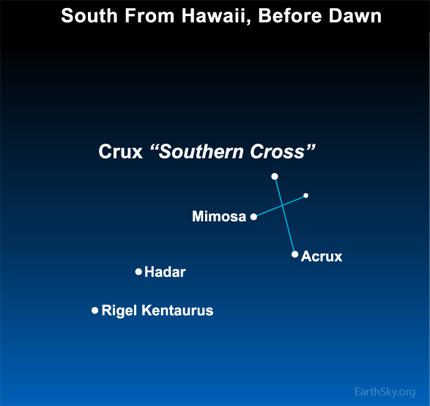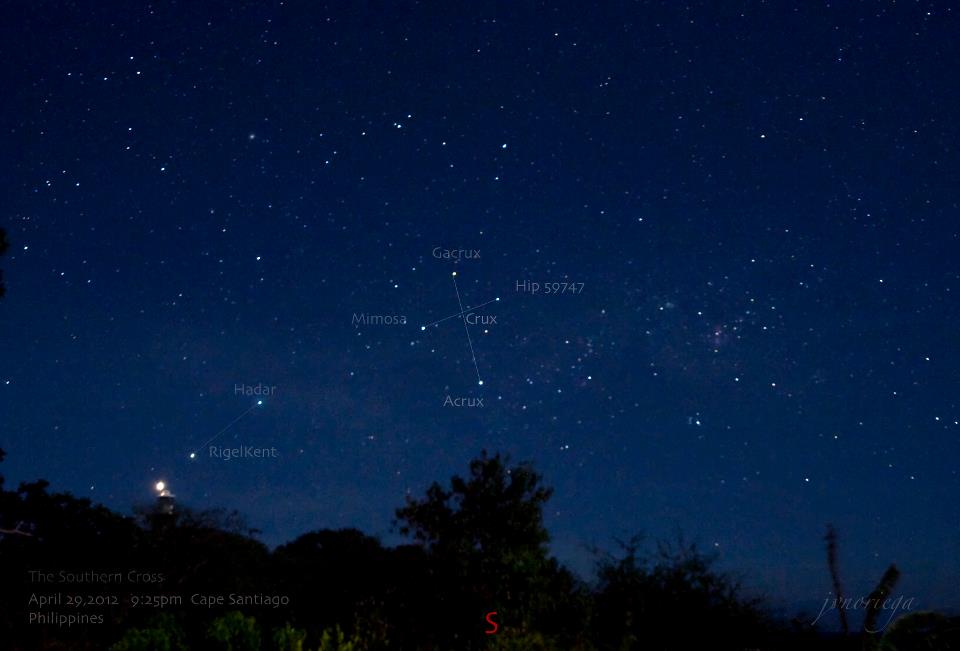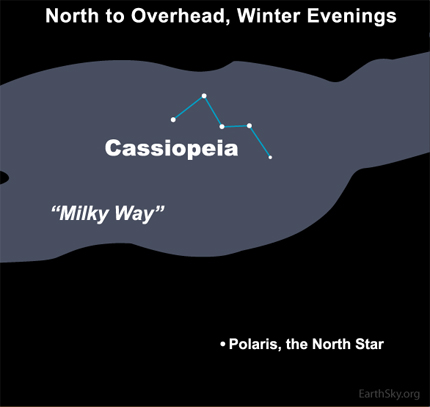
TONIGHT FORDECEMBER 29, 2012
A reader asked, When can I see the Southern Cross in Hawaii? The answer is now, but you’ll have to look for it at just the right place and time. Each year in late December and early January, Hawaiians – or those at the latitude of Hawaii – can see the Southern Cross in the southern sky briefly before dawn. The Southern Cross, aka the constellation Crux, stands close to upright, but quite low in the sky for the latitude of Honolulu. Notice the two nearby stars, Rigel Kentaurus and Hadar, in the constellation Centaurus. Rigel Kentaurus is also known as Alpha Centauri, the star system nearest to Earth, at a little more than four light-years away. It and Hadar point to the Southern Cross.
Hawaii is at 21 degrees N. latitude. Other cities at about this same latitude include Mecca in Saudi Arabia, Leon and Guanajuato in Mexico, and Hanoi in Vietnam. All of you at this latitude will be able to see the Southern Cross before dawn for at least another month.
Are you south of Hawaii’s latitude? Then you can see the Southern Cross, Rigel Kentaurus and Hadar all higher in the sky before dawn now. From Australia or New Zealand now – or South America or South Africa – Crux is circumpolar. That is, it circles around the sky’s southern pole and appears for most, if not all, of the night.

Here is the Southern Cross as seen from Manila – latitude 14 degrees N. of the equator – on an April evening in 2012. The photo is from EarthSky Facebook friend Jv Noriega. Thank you, Jv! Make larger.

If you can see the constellation Cassiopeia in your northern sky, then the Southern Cross is below your horizon. Cassiopeia is shaped like the letter M or W.
How can I know if the Southern Cross is visible in my sky? If you know a bit about the sky, then there is one surefire way to know if the Southern Cross is visible in your sky. When the easy-to-find constellation Cassiopeia the Queen is visible in your sky, the Southern Cross is below your horizon. So, for example, Cassiopeia lights up Hawaiian skies on winter evenings, but it sets beneath Hawaii’s northern horizon several hours before sunrise. As Cassiopeia sets, the Southern Cross rises.
Meanwhile, for latitudes north of Hawaii (for example, the southernmost continental U.S.), Cassiopeia is circumpolar. It circles endlessly around the sky’s north pole and never sets. Therefore, the Southern Cross never rises as seen from northerly latitudes.
The Southern Cross marks the southern terminus of the glowing band of stars that we call the Milky Way – really the edgewise view into our own Milky Way galaxy. Meanwhile, Cassiopeia lodges at the Milky Way’s northern terminus in our sky.
This U.S. Naval Observatory page tells you the rise and set times for the Crux star Mimosa, and the stars Hadar and Rigel Kentaurus.
No comments:
Post a Comment